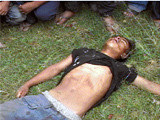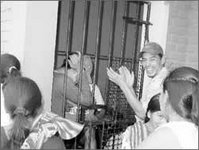
This is Jose Pomacusi, who is Bolivian President Evo Morales's scourge in the news media. Pomacusi, 41, is the news director for
Unitel, the country's most-watched television network. It has grabbed ratings with its soap operas and its sensationalistic and right-leaning news coverage. When Evo Morales talks about the press being his No. 1 enemy, Unitel is at the top of the list.
The station is owned by the Santa Cruz-based Monasterio family, whose interests include soybean farming, banking and other businesses. Monasterio reflects sentiments of most businesspeople in Santa Cruz, who oppose the government's plan for redistributing land to indigenous people, the nationalization of various industries and the centralization of political power in La Paz.
Pomacusi told me in an interview that he is not trying to advance any particular political philosophy, only to serve the public. However, neutral observers can easily identify the station's anti-government and pro-business tendencies.

Pedro Rivero is director (editor-in-chief) of
El Deber and son of the newspaper's founder. The Rivero family is one of the few media owners in the country whose primary business is media. That is to say that most news media owners use their outlets to advance political or business agendas, like the Monasterios. El Deber has the highest circulation of any newspaper in the country, about 30,000 daily and 50,000 Sunday (figures are not audited and some say these numbers are on the high side), and is the voice of the Media Luna, the four eastern provinces which favor autonomy.
The Riveros take journalism very seriously, and their news columns are generally very balanced and fair in their treatment of issues. Their editorial page reflects Santa Cruz sentiments, but El Deber also carries opinion pieces by those who favor President Morales and his party.
Big complaints about the news mediaWhen conversations turn toward the news media, few have anything good to say. The general public complains about sensationalism in television news coverage, particularly aggressive coverage of grieving families. The commonly expressed view is that the press is unethical, politically slanted, nosy, tasteless and too concerned with trivia, celebrities and sensuality.
The socialist government complains about right-leaning news coverage from media that are owned by, in their words, big land-owners and big businesses with an opposition agenda.

Erick Torrico is being interviewed here as he presented a study by the
Media Observatory, a nonpartisan organization which describes and analyzes the performance of news media in the country. A lot of its funding comes from European and U.S foundations. No surprise that the observatory found big weaknesses in the press in terms of training, execution and fairness. Although there was a fair amount of publicity about his presentation, only a handful of people showed up.
El Deber
summarized the study in today's paper.
The organization asked 33 "social leaders" in the community of Santa Cruz, "Do journalists work in a professional manner?" Only one-fourth of those polled responded "always" or "nearly always" and 39 percent responded "almost never." Of those polled, 4 in 10 felt that the press's professionalism had deteriorated in the past five years. And finally, when asked which news medium had the best information, printed media came in strongest with 48% of those polled, radio 39% and TV 3%. Nine percent didn't like any news medium.
At a time of big changes in the country, every story is a political story. For consumers of news, that often leads to baffling news articles in which there is extensive coverage of opposing views of an issue (nationalization of the gas industry) with too little probing into the facts at the root of the debate. A reader often is left with many, many questions. Still, daily newspapers tend to be voices of reason in the media landscape, with the space and time to give some depth and balance to issues.
A push for controls on the news mediaMeanwhile, the Constitutional Assembly is in the process of drafting a new constitution for the country, and indications are that there is strong sentiment for putting controls on the news media. El Nuevo Dia had a
story about this in yesterday's paper......
One part of the draft says that the ownership and control of news media "shall not reflect a monopolistic or oligarchic character in opposition to society in general and indigenous people, workers and those of African descent." This sounds as if it would outlaw most of the mass media as they now exist.
Given the complaints about the media, controls could win popular support. There is fear that Bolivia will start to follow in the footsteps of Venezuela, whose president and Morales supporter, Hugo Chavez, has fined and closed down opposition media.
 Work by Santa Cruz photojournalists
Work by Santa Cruz photojournalistsAll of these photos were in a photojournalism show here in Santa Cruz
This little boy showed up for the first day of school without his uniform. The Superman symbol seems to be no consolation.
A supporter of the president´s MAS party shows her displeasure with one of a group supporting autonomy from the central government Dec. 15 in San Julian.


This year´s El Niño effect produced widespread flooding in farming areas.

Bodies of victims of a bus crash are lined up along the road. Fatal crashes are common. Drivers are overworked and often drunk. Guardrails are rare.

Most public schools here are in sorry shape.



















































